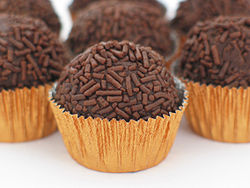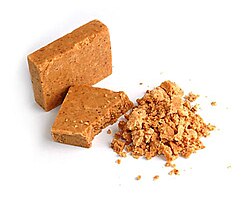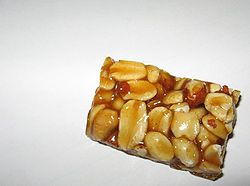| Name | Image | Description |
|---|
| Abará ( pt ) | 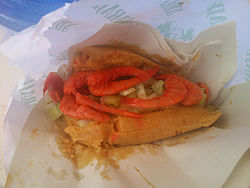 | Abará uses the same dough, made from black-eyed peas, as acarajé, the only difference is that the abará is steamed, while acarajé is fried. |
| Aberém ( pt ) | | A typical cuisine of Bahia, Aberém is a cookie of African-Brazilian origin, made from corn or rice that is stone ground, macerated in water, salted and cooked in dried banana leaves. |
| Acarajé |  | Made from peeled black-eyed peas formed into a ball and then deep-fried in dendê (palm oil). It is found in Brazilian cuisine and Nigerian cuisine. The dish is traditionally encountered in Brazil's northeastern state of Bahia, especially in the city of Salvador, often as a street food. |
| Acaçá | | A steamed porridge of coconut milk and rice flour |
| Arabu | | A typical Brazilian dish consisting of raw (or slightly cooked) turtle eggs, accompanied by cassava flour and seasoned with some salt. |
| Arrumadinho ( pt ) | | Made with cassava or jerky, farofa, vinaigrette, green beans and seasoned with clarified butter |
| Bauru |  | A popular Brazilian sandwich. The traditional recipe calls for cheese (usually mozzarella) melted in a bain-marie, slices of roast beef, tomato and pickled cucumber in a French bun with the crumb (the soft inner part) removed. |
| Bolacha sete-capas ( pt ) | | Composed of seven thin layers of a dough consisting of wheat flour, coconut milk, butter or margarine and hydrogenated vegetable fat. |
| Bolinho | | Varieties include bolinho de bacalhau, bolinho de chuva, bolinho caipira, cheese balls, student cake and manioc cake. |
| Broa |  | A type of cornbread traditionally made in Portugal and Galicia, as well as in Brazil, where it is traditionally seasoned with fennel. |
| Cabeça de galo | | Originating from northeastern Brazil, particularly the states of Pernambuco and Paraíba, it consists of a broth of cassava flour with eggs and spices (especially pepper) and may contain other ingredients such as tomato and onion. |
| Cabidela |  | Made with poultry or rabbit. After the fowl or rabbit is killed, they are hung up upside-down, so the blood may be captured as it drains out. The rice is then cooked together with the meat and the blood of the animal, which imparts a greyish-brown color to the dish. |
| Cachorro-quente |  | In Brazil, hot dogs are typically served in a bread roll with a tomato-based vegetable broth, corn, and potato sticks. |
| Catupiry |  | One of the most popular "requeijão" (processed cheese) brands in Brazil. It was developed by the Italian immigrant Mario Silvestrini in the state of Minas Gerais in 1911. |
| Chana | 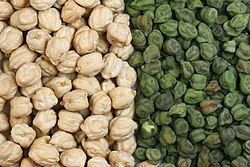 | Chickpeas |
| Coxinha |  | "Little chicken thigh" –a popular food in many countries in South America. The drumstick is a Brazilian snack originally from São Paulo, and based on dough made with wheat flour and chicken broth, which is filled with spiced chicken meat. |
| Coxinha de farofa |  | A typical snack from Lapa, it is made by covering chicken meat farofa with pastel dough and molded in a shape that resembles a straw. |
| Deep-fried cassava |  | Fried cassava (mandioca, aipim, or macaxeira) is a typical substitute for French fries in Brazil. It is commonly served in bars along with beer. |
|
| Farofa |  | A toasted manioc flour mixture. In Brazil, where farofa is particularly popular, typical recipes call for raw manioc flour to be toasted with butter, salt, and bacon until golden brown, being incremented with numerous other ingredients. It is an essential accompaniment to feijoada. Variants include farofa d'água, farofa de içá and farofa de tanajura. |
| Ginga com tapioca | | A traditional food in Natal, Rio Grande do Norte, made of fried fish and served inside Brazilian tapioca. |
| Misto-quente | 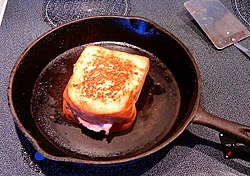 | It's a simple ham and cheese sandwich in sliced bread, with or without butter. Can be served quente (pressed hot) or frio (just mounted and served). |
| Pamonha | 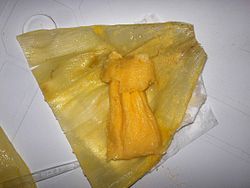 | A traditional Brazilian food, it's a paste made from fresh corn and milk, boiled wrapped in corn husks, turned into a dumpling. Variations include pamonha de milho and pamonha de carimã, and some variants use coconut milk. |
| Pão de queijo | 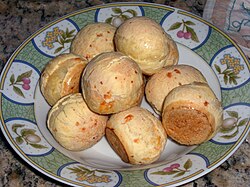 | A small, baked, cheese-flavored roll/bun/puff. It's a very popular snack and breakfast food all over Brazil, but especially in the state of Minas Gerais. These cheese puffs are distinctive not only because they are made of cassava or corn flour, but also because the inside is chewy and moist with a crumbly crust around. |
| Pastel | 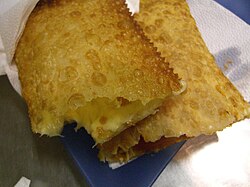 | A fast food dish consisting of thin pastry envelopes wrapped around assorted fillings, then deep fried in vegetable oil, resulting in a brown, crisp pastry. The most common fillings are ground meat, mozzarella, heart of palm, catupiry cream cheese, chicken and small shrimp. Variants include pastel de angu. |
| Queijo de coalho | 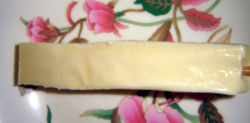 | A firm and lightweight cheese produced in Northeastern Brazil, with an almost 'squeaky' texture when bitten into. It is a popular snack on the beach in Brazil, where walking vendors brown rectangular slabs of it in hand-held charcoal ovens. |
| Queijo Minas | 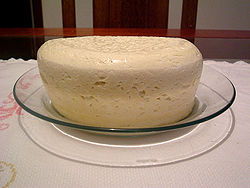 | A type of cheese that has been traditionally produced in the Brazilian state of Minas Gerais. It comes in three varieties, named frescal (fresh), meia-cura (slightly matured) and curado (matured). A fourth variety, branded queijo padrão (standard cheese) has been developed more recently and can be found in nearly all supermarkets and grocery stores in Brazil. |
| Quibebe | | A winter squash soup originating from Northeastern Brazil. |
| Requeijão |  | A milk-derived product similar to cream cheese, produced in Brazil. It's a spread that resembles ricotta in colour and flavour, but much creamier. |
| Rissole | | In Brazil, rissoles are often filled with sweetcorn, cheese, chicken or shrimp. See below, salgados. |
| Salgado or salgadinho |  | Many different kinds of finger food which can be small (for parties) or bigger (for bakeries, as snacks and even replacing meals), usually consisting of dough wrapped around chopped meat, chicken, ham and/or cheese. |
| Tapioca | 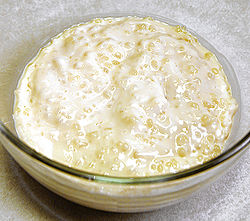 | A starch extracted from Manioc (Manihot esculenta). This species is native to the Northeast of Brazil but spread throughout the South American continent. The plant was spread by Portuguese and Spanish explorers to most of the West Indies, Africa and Asia, including the Philippines and Taiwan, being now cultivated worldwide. In Brazil, the plant (cassava) is named "mandioca", while its starch is called "tapioca". |
| Torresmo |  | Pork rinds. See also: Chicharrón. |











































